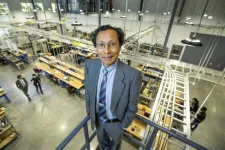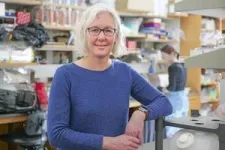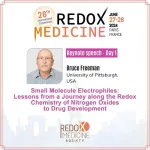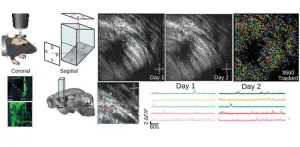(Press-News.org) When FAMU-FSU College of Engineering Professor Fang Peng was a boy, he saw the power and peril of electricity firsthand.
He was in middle school when his remote Chinese hometown first received electric service. His family shared a single portable, 15-watt light bulb attached to a cable. It was his job to replace the bulb.
“One night, the bulb went out and I tried to change it in total darkness,” Peng said. “I accidentally stuck my left thumb in the socket and was immediately shocked. I got knocked off balance and down to the dirt floor, trembling as the electricity seared through my body. Luckily, my right hand got tangled with the cable and pulled the socket off my left hand, otherwise I would not have survived.”
After that near-death experience, Peng saw electricity as a challenge. He made it his life’s work to study the phenomenon and “tame the beast” that put him in danger but also allowed his family to see at night.
Peng’s latest research continues that mission. In a study published in Scientific Reports, he shows how a semiconductor device he created, named a Z-source inverter, can rapidly reduce voltage and current in the case of a short-circuit or open-circuit fault.
Existing safety mechanisms that stop electricity during a fault work quickly, but not always quickly enough. A typical circuit breaker could take around 50 milliseconds to activate — still long enough to kill a person or spark a fire. Peng’s digital Z-source converter/inverter can protect in 5 microseconds, or 1,000 times faster.
HOW IT WORKS
When a circuit is operating normally, power lines and cables carry electrical current over a long distance from generators to end users, whose use is called the load in an electric system. Engineers typically want it to be running as strong as possible to provide power to end users. But when something breaks or shorts the circuit, such as a downed tree, the current travels through that object. Electrical flashes that reach 35,000 degrees Fahrenheit can cause objects contacting the circuit to heat up fast and burn with intensity.
Peng’s electronic switch detects short circuits faster than existing methods. It can also handle a wide range of input voltages without needing extra components. This flexibility makes it useful in situations where the power supply isn’t constant or when you need to work with different voltage levels efficiently.
“We developed a way for the power source to be more responsive to the load,” he said. “Without end users noticing, we can immediately bring the power grid back to normal, without a surge current.”
WHY IT’S IMPORTANT
Downed power lines spark hundreds of wildfires every year in the United States. The 2023 Maui wildfires were some of the deadliest in U.S. history. According to the National Fire Protection Association, that fire started when a tree that had toppled onto a power line ignited.
“The purpose of our study is to make the energy source (voltage) more responsive to the loading condition,” Peng said. “If there is an unexpected large current, we want to reduce the voltage to a safe range to prevent fires. Traditional generators keep generating a constant voltage regardless of the current.”
RE-ENGINEERING THE GRID
Peng’s solution can be used to retrofit existing infrastructure to make it safer.
Diversifying the power grid with renewable energy sources like wind turbines, photovoltaic cells, and fuel cells is one way to regulate increases and decreases in voltage.
“Besides renewables, another way we can prevent surges in power is to artificially regulate the system with a power converter,” Peng said. “Whether natural or artificial, we want to create something that works autonomously with self-protection, resiliency and redundancy. One idea is to use a virtual resistor implemented by power electronics and control to provide the damping and stabilization of the circuit system.”
Much of the electric grid in the United States was built and expanded in the 1960s and 1970s. Along with fires from downed power lines, aging infrastructure poses other problems, such as power outages or vulnerability to cyberattacks.
“It is time to remake our grids and ‘tame the beast’ with power electronics, a new power technology which started flourishing in the 1980s when I started my research career,” Peng said. “I was truly lucky to become a protégé of several power electronics pioneers and world leaders. It takes a village to raise a child, and it takes the whole society/world to make this new grid happen.”
Peng’s research was supported by the U.S. Department of Energy and the Solar Energy Technologies Office.
END
Taming the beast: FAMU-FSU researcher controls voltage response for safer electric grid
2024-03-26
ELSE PRESS RELEASES FROM THIS DATE:
Professor Bruce Freeman: Keynote Speaker of the 26th International Conference of the Redox Medicine Society
2024-03-26
Bruce A. Freeman, Irwin Fridovich Distinguished Professor and Chair at the University of Pittsburgh School of Medicine Department of Pharmacology & Chemical Biology, will introduce Redox Medicine 2024 with a key note talk titled "Small Molecule Electrophiles: Lessons from a Journey through Studying the Redox Chemistry of Nitrogen Oxides to Drug Development”.
The 26th International Conference of the Redox Medicine, Redox Medicine 2024, will take place on June 27-28 at Fondation Biermans Lapôtre in Paris, France.
Professor Freeman will discuss the generation and actions of nitrogen oxide-derived fatty acid nitroalkenes in the context of ...
Penn Medicine study reveals inequities in access to transformative CAR T cell therapy
2024-03-26
PHILADELPHIA – Patients being treated for B-cell non-Hodgkin’s Lymphoma (NHL) who are part of minority populations may not have equal access to cutting-edge CAR T cell therapies, according to a new analysis led by researchers from the Perelman School of Medicine at the University of Pennsylvania and published today in NEJM Evidence.
CAR T cell therapy is a personalized form of cancer therapy that was pioneered at Penn Medicine and has brought hope to thousands of patients who had otherwise run ...
Artificial reef designed by MIT engineers could protect marine life, reduce storm damage
2024-03-26
The beautiful, gnarled, nooked-and-crannied reefs that surround tropical islands serve as a marine refuge and natural buffer against stormy seas. But as the effects of climate change bleach and break down coral reefs around the world, and extreme weather events become more common, coastal communities are left increasingly vulnerable to frequent flooding and erosion.
An MIT team is now hoping to fortify coastlines with “architected” reefs — sustainable, offshore structures engineered to mimic the wave-buffering effects of natural reefs while also providing pockets for fish and other marine ...
Biotechnology CEO and inventor of SiriusXM Satellite Radio Martine Rothblatt to deliver graduation address to the University of Maryland School of Medicine’s 215th graduating class
2024-03-26
University of Maryland School of Medicine (UMSOM) Dean Mark T. Gladwin, MD, announced today that Martine Rothblatt PhD, JD, MBA, Chairperson and CEO of United Therapeutics, and inventor of SiriusXM Satellite Radio, will deliver the keynote address for this year’s graduating medical student class. The UMSOM MD graduation ceremony will take place at the Hippodrome Theatre on Thursday, May 16, 2024. The ceremony will begin at 1:00 pm. Details for faculty members are here. Details for students/guests are here.
Dr. Rothblatt is a trailblazing pioneer of several innovations in biotechnology, pharmaceuticals, and satellite communications. After developing SiriusXM, ...
ORIGAMI: anticipating the future of more connected, efficient and sustainable telecommunication infrastructures
2024-03-26
The ORIGAMI (Optimized Resource Integration and Global Architecture for Mobile Infrastructure for 6G) project is now underway. The project, funded by the European Commission under the Horizon Europe program, will spearhead architectural innovations for the next generation of 6G mobile networks, to enable innovative applications, new business models, and substantial reductions in energy consumption.
By proposing and developing three critical architecture innovations – Global Services Based Architecture (GSBA), Zero Trust Exposure Layer (ZTL), and Continuous Compute ...
Study says it’s time to highlight positive skills associated with neurodevelopmental conditions
2024-03-26
New research says the wide variety of skills displayed by people with conditions such as ADHD, dyslexia and autism should be celebrated to help reduce stigma and change society’s expectations.
Creativity, resilience and problem-solving are just some of the strengths exhibited and a study is now calling for a change in the way we think about people with neurodevelopmental conditions.
Dr Edwin Burns, senior lecturer from the School of Psychology at Swansea University, worked with academics from Edge Hill University on the study and their findings have just been published by ...
Corporations use government grants to lighten debt load
2024-03-26
Local and state governments have a variety of tools at their disposal to attract businesses or entice them to stay. One is tax relief. Austin, for example, helped lure electric automaker Tesla in part with property tax rebates worth $14 million over 10 years.
In a study released today from Texas McCombs, Dean and Accounting Professor Lillian Mills finds that another kind of government aid — cash grants — has a different kind of impact. It helps companies lighten their balance sheets by borrowing less.
Corporations ...
C-Path launches consortium for alpha-1 antitrypsin deficiency
2024-03-26
TUCSON, Ariz., March 26, 2024 — Critical Path Institute (C-Path) is excited to announce the launch of the Critical Path for Alpha-1 Antitrypsin Deficiency (CPA-1) Consortium. The CPA-1 consortium aims to accelerate drug development for alpha-1 antitrypsin deficiency (AATD), a rare disease that affects individuals and families worldwide. This will be achieved by integrating data through C-Path’s Rare Diseases Cures Accelerator–Data Analytics Platform (RDCA-DAP®) and leveraging those data for CPA-1 to collaboratively develop regulatory-grade solutions to continuously address unmet needs in drug development for this condition, including:
Generating evidence to ...
In paleontology, correct names are keys to accurate study
2024-03-26
COLUMBUS, Ohio – When the skeletal remains of a giant ground sloth were first unearthed in 1796, the discovery marked one of the earliest paleontological finds in American history.
The animal, named Megalonyx by Thomas Jefferson in 1799, was the first genus of fossil named from the United States. Thought to have roamed North America during one of the last ice ages, the extinct giant ground sloth was an herbivorous mammal resembling a large bear — at full size, it likely reached nearly 10 feet tall (3 meters) and weighed about as much as a small elephant.
The report made by Jefferson, an avid fossil collector who was known to keep ...
Imaging deep brain activity with microprisms
2024-03-26
Organisms constantly face the challenge of adapting their behavior to survive in a world full of uncertainties. This ability relies on complex neural circuits in the brain that help them find resources while avoiding danger. Scientists study how these neural circuits change over time to understand better how behaviors emerge.
One powerful way to study these changes is through optical imaging techniques that allow researchers to track the activity of individual brain cells. Traditional methods rely on observing the activity of cells directly, ...





